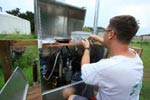Single-use filter pouches and community supporting hydro-wells will purify 1,480 gallons of water a day for survivors of the Haiti earthquake.
Rodney O. Corr discharged fill material into approximately 14 acres of wetlands to clear a site for commercial development without applying for a Clean Water Act Section 404 permit.
With supportive public comments, the agency says it plans to involve the community as Dow proceeds with its Superfund work in two Michigan waterways and continues to comply with its Resource Conservation and Recovery Act license.
The federal agency is proposing numerical nutrient limits on Florida's lakes, rivers, streams, springs and canals, in response to a 2009 consent decree with the Florida Wildlife Federation.
Oklahoma oil production facility paid $900 and certified that it has corrected all identified discrepancies, including appropriate spill containment and employee training.
The U.S. Army Corps of Engineers plans to dredge sediment to maintain proper depth for ship traffic but this action may affect the polychlorinated biphenyls.

Inconsistent federal, state and local laws are undercutting groundwater protection efforts in the United States.
- By Michael E. Covert, P.G.
Oracle Utilities worked with O'Keeffe & Company to tap into the thinking of 1,210 adults and 302 water utility managers in the United States and Canada about water conservation.
- By L.K. Williams, EPonline
Resource Environmental Solutions says oil and gas companies and developers who impact wetlands in Louisiana can offset their impacts by purchasing credits.
University of Georgia researchers found that, among other things, restoring natural water flows can change the vegetation and negatively affect animals.
Because freshwater mussels are more sensitive to ammonia than currently understood, EPA has proposed a revision to its criteria dataset.
Green building consultant Jerry Yudelson offers his insights on the green building industry.
Agency works with mountaintop mining companies to ensure compliance with Section 404 of the Clean Water Act.
The third WaterSmart Innovations conference is set for Oct. 6-8, 2010 at the South Point Hotel and Conference Center.
Bay states will face consequences for inadequate nutrient reduction plans for the Chesapeake Bay, including expansion of coverage responsibility and additional EPA oversight.
On Jan. 5, EPA will present a Webcast on the draft findings of the National Lakes Assessment.
A Natural Resources Defense Council report says atrazine is severely contaminating drinking water in Illinois, Iowa, Indiana, Missouri, and Nebraska.
The Justice Department submitted a consent decree covering the 2004 spills of anhydrous ammonia in Nebraska and Kansas that killed an estimated 21,000 fish.